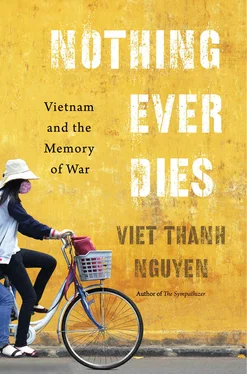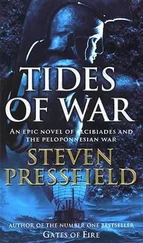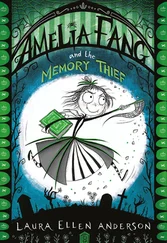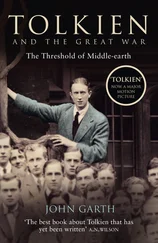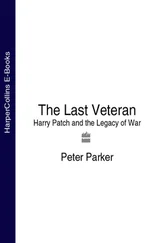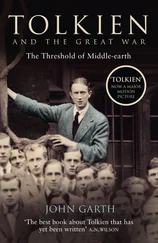On a smaller scale and in the middle of the country, the Son My museum that commemorates the My Lai massacre focuses on the singular tragedy of the five hundred people murdered — some raped — by American troops. The aftermath of their story is the same as the common narrative, the triumphant revolution eventually transforming the war-blasted landscape of village and province with verdant fields, new bridges, lively schools, and lovely people. While the photographs that decorate these museums feature real people, the captions underlining them have stamped them flat, as in the Son My museum’s display of Ronald Haeberle’s most famous photograph, underwritten with this: “The last moment of life for villager women and children under a silk cotton tree before being murdered by the U.S. soldiers.” Whoever these civilians and soldiers were in their complex lives and complicated histories, they exist in the caption as victims and villains in a drama that justifies the revolution and the party. The caption as genre echoes the slogan as genre, from Follow Uncle Ho’s Shining Example to Nothing Is More Precious than Independence and Freedom. Slogans like these exemplify the Communist Party’s story of itself, which has become, for now, the official story of the country and the nation.
Past these captions, slogans, and official commemorations, round characters do exist and are also a part of the ethics of remembering one’s own. They walk and breathe in a few works of art that deviated from the dominant story and yet found their way to readers and viewers. Bao Ninh’s The Sorrow of War was one, a landmark novel that expressed, for the first time, how the noble war to liberate the Fatherland was oftentimes horrific for the soldiers who fought in it. The novel begins in the months following the end of the war, with a team searching for the missing and the dead in the Jungle of Screaming Souls. Kien, the soldier at the novel’s center, hears the dead too well. Once an idealistic volunteer and now a collector of corpses, he has been “crushed by the war.” 10The sole survivor of his platoon, he vividly remembers the men and women he killed as well as his dead comrades. Still, he might have been able to bear these horrors but for the gangrenous disillusionment of the postwar years. “This kind of peace?” says the driver of the truck bearing the dead, among whom Kien sleeps. “People have unmasked themselves and revealed their true, horrible selves. So much blood, so many lives were sacrificed — for what?” 11This is the universal question of the disillusioned soldier.
In an effort to make sense of death and disillusionment, of being surrounded by the dead, Kien becomes a writer. He is intent on imposing a plot on the past, “but relentlessly, his pen disobeyed him. Each page revived one story of death after another and gradually the stories swirled back deep into the primitive jungles of war, quietly restoking his horrible furnace of war memories.” 12Gusts of images swirl from this furnace until they settle near the novel’s end, leaving him with two traumatic memories. 13The first is the fate of Hoa, a female guide who led his men toward the safety of Cambodia. When American troops hunt them, she stays behind as a decoy, killing their tracker dog. After they capture her, the Americans, black and white, take turns raping her. Kien watches from a distance, too afraid to save her. Remembering this horrible scene provokes Kien into recalling another scene that came before it. In the earlier event, a teenage Kien sets off to war, accompanied on the train by his beautiful girlfriend Phuong. He is so devoted to her that he cannot bring himself to make love to her, despite her repeated invitations. This purity is a symptom of weakness rather than strength, at least in terms of how he perceives his masculinity. His weakness is revealed to him on the train, when he cannot protect her from fellow soldiers intent on gang-raping her. Years later, “he suddenly remembered what he thought he had seen in the freight car and what could still be happening there. He was to remember that as his first war wound.… It was from that moment, when Phuong was violently taken from him, that the bloodshed truly began and his life entered into bloody suffering and failure.” 14
Too late and too fearful to save Phuong from the rapes she has already endured, the teenage Kien murders his first man, a sailor who tries to be next in line. Eventually he becomes an able killer, but despite his lethal ability, he will not save Hoa and cannot save Phuong from “what could still be happening there,” raped by men driven by the same murderous urges found in Kien. If he gave in to murder, these other men gave in to rape, the erotic indistinguishable, at one extreme, from the homicidal. Rape is the hidden trauma, its climactic revelation destroying the masculine fiction that war is a soldier’s adventure and a man’s experience, or that war — over there — can be separated from the domestic world of the family, over here. “Can’t you see?” Phuong cries after the rape. “It’s not a wound! It can’t be bandaged!” 15The disturbing images of sexual violation at the novel’s end incinerate the gentler language earlier in the novel, when Kien thinks how “the sorrow of war inside a soldier’s heart was in a strange way similar to the sorrow of love. It was a kind of nostalgia, like the immense sadness of a world at dusk. It was a sadness, a missing, a pain which could send one soaring back into the past.” 16The novel traces this journey into the past, where war and love’s paper-thin abstractions are fed into memory’s hot furnace, the ashes revealing how the heady ideals of romance, purity, and patriotism devolve into rape, slaughter, and trauma.
But what is the relationship of these rounded characters of memorable fiction to the flat characters of the country’s cemeteries, museums, and propaganda? While round characters are sometimes antiheroic, and the flat characters of one’s own side are usually heroic, both enact the ethics of remembering one’s own. Regardless of whether those we remember are saintly or all too human, the ethical force of remembering one’s own reinforces the shared identities of family, nation, religion, or race. In the ethics of remembering one’s own, remembering those of one’s side, even when they do terrible things, is better than ignoring them altogether. Nothing is worse than being ignored, erased, or effaced, as the losers of any war or conflict can affirm. In memory wars, a victory is had in simply being remembered and being able to remember, even if one’s self and one’s own appear troubled, tortured, even demonic. The antiheroic version of this kind of ethics dwells in the nebulous world of the chiaroscuro, half-lit, half-obscured. No surprise, then, that by the end, Kien the writer vanishes from his apartment and into the shadows, leaving only his manuscript. The last words of the novel, spoken by the unnamed person who discovers Kien’s manuscript, commemorates why the warrior and writer must disappear: “I envied his inspiration, his optimism in focusing back on the painful but glorious days. They were caring days, when we knew what we were living and fighting for and why we needed to suffer and sacrifice. Those were the days when all of us were young, very pure, and very sincere.” 17The war and the Communist Party may be condemned in the pages of the novel, but not the young people and the true patriots who sacrificed themselves. Both an idealist in looking back and a cynic in looking at the present, Kien is not fit to live in a postwar society that only speaks about the glorious brightness of war. He, like many of the war’s survivors, men and women both, dwell in the crepuscular margins of melancholy, loss, and sorrow.
At least these veterans of the revolution are remembered by their country in some way, even if inadequately. In contrast, those who fought for the losing side are disremembered. They can be discovered by driving on from the Truong Son Martyrs Cemetery and heading further south on Highway 1A. This is the nation’s main artery, a crowded, noisy, and slow two-lane road running the length of the coast and lowland interior. This trans-Vietnamese route eventually reaches the outskirts of Ho Chi Minh City, or what many still prefer to call, for reactionary, sentimental, or simply lyrical reasons, Saigon (itself a name of memory and forgetting, given to a city conquered by the Vietnamese people on their great march south, a history remembered by the Vietnamese as a feat of nation-building rather than bloody imperialism). Past the industrial zone on Saigon’s edge where the sky is always a sheet of smog, one will see, on the border of the highway, a grand martyrs cemetery. A towering statue of a mother grieving for these martyrs gazes across the highway. The crowded landscape of factories, billboards, and roadside homes she sees is unremarkable, unless one knows what was once there. Many years ago, during the war years and before the victors built the martyrs cemetery, there sat on the other side of the highway another statue, a soldier of the Army of the Republic of Vietnam, pensive on a rock as he gazed on the road from his modest six-meter height. 18Behind him was the vast national cemetery for this southern army.
Читать дальше
